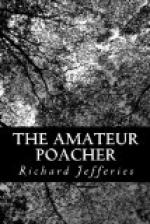The way to walk noiselessly is to feel with the foot before letting your weight press on it; then the dead stick or fallen hemlock is discovered and avoided. A dead stick cracks; the dry hollow hemlock gives a splintering sound when crushed. These old hemlock stems were numerous in places, together with ‘gicksies,’ as the haymakers call a plant that resembles it, but has a ribbed or fluted instead of a smooth stalk. The lads use a long ‘gicks’ cut between the joints as a tube to blow haws or peggles at the girls. When thirsty, and no ale is handy, the men search for one to suck up water with from the brook. It is difficult to find one free from insects, which seem to be remarkably fond of anything hollow. The haymakers do not use the hemlock, thinking it would poison the water; they think, too, that drinking through a tube is safer when they are in a great heat from the sun than any other way.
Nor is it so easy to drink from a stream without this simple aid. If the bank be flat it is wet, and what looks like the grass of the meadow really grows out of the water; so that there it is not possible to be at full length. If the bank be dry the level of the water is several inches lower, and in endeavouring to drink the forehead is immersed; often the water is so much lower than its banks that it is quite impossible to drink from it lying. By the edge grasses, water-plantains, forget-me-nots, frequently fill the space within reach. If you brush these aside it disturbs the bottom, and the mud rises, or a patch of brown ‘scum’ comes up and floats away. A cup, though gently used, generally draws some insects in with the water, though the liquid itself be pure. Lapping with the hollowed palm requires practice, and, unless the spot be free from weeds and of some little depth, soon disturbs the bottom. But the tube can be inserted in the smallest clear place, and interferes with nothing.
Each of us carried a long hazel rod, and the handle of a ‘squailer’ projected from Orion’s coat-pocket. For making a ‘squailer’ a teacup was the best mould: the cups then in use in the country were rather larger than those at present in fashion. A ground ash sapling with the bark on, about as thick as the little finger, pliant and tough, formed the shaft, which was about fifteen inches long. This was held upright in the middle of a teacup, while the mould was filled with molten lead. It soon cooled, and left a heavy conical knob on the end of the stick. If rightly thrown it was a deadly missile, and would fly almost as true as a rifle ball. A rabbit or leveret could thus be knocked over; and it was peculiarly adapted for fetching a squirrel out of a tree, because, being so heavy at one end, it rarely lodged on the boughs, as an ordinary stick would, but overbalanced and came down.
From the outlook of the oak some aspen trees could be seen far up in the withy-beds; and it had been agreed that there the first essay of the stream should be made. On arriving at these trees we paused, and began to fix the wires on the hazel rods. The wire for fish must slip very easily, and the thinner it is, if strong enough, the better, because it takes a firmer grip. A single wire will do; but two thin ones are preferable. Thin copper wire is as flexible as thread. Brass wire is not so good; it is stiffer, and too conspicuous in the water.




